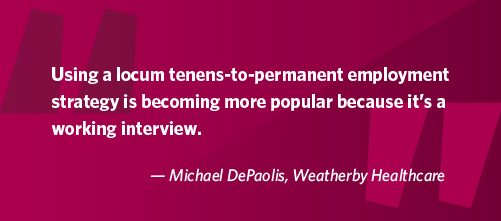One doctor can generate an average of almost $2.4 million per year for a hospital — with some specialties driving even higher revenue. With a projected shortage of as many as 124,000 physicians by 2034, it’s hard to imagine the financial impact on a hospital or private practice when it loses a physician to turnover or retirement without having a replacement doctor ready to fill the vacancy.
A 2023 study by the Association for Advancing Physician and Provider Recruitment (AAPPR) found that the time to fill an open physician position was 240 days for specialty physicians and 125 days for primary care, on average. And it’s costly too. The expense of interviewing, recruiting, and processing a new provider runs between $30,000 and $90,000 per individual. Few organizations can sustain financial losses at that level long term, especially if those losses are multiplied by several staffing voids.
However, physician vacancies don’t have to linger that long. The locum tenens staffing option offers facilities an opportunity to develop a more sustainable cost-benefit ratio. Let’s break down some of the financial components of locum tenens.
Maintaining facility revenue streams
Physicians are a primary revenue-generating factor, and if positions remain open for prolonged periods, healthcare organizations could take a big hit on their bottom lines. Bringing in locum tenens can compensate for some of that deficit. In fact, 46% of healthcare organizations using locums do so to prevent revenue loss, according to the 2024 State of Locum Tenens Report by CHG Healthcare.
“More and more healthcare organizations are weighing the cost of bringing in locum tenens providers versus the cost of not having coverage and finding that locums makes a lot of financial sense,” says Michael DePaolis, senior vice president for Weatherby Healthcare.

Simply put, locum tenens physicians care for patients so you retain service levels and a reliable revenue stream.
Staff turnover or retirement, however, aren’t the only reasons facilities and private practices partner with locum tenens staffing agencies. Vacations, family and medical leave, and spikes in census also drive up demand for clinicians, and for which short-term contracts make more fiscal sense than expanding permanent staff.
Calculating the cost of locum tenens
Of course, contracting with an outside staffing company does have a cost. So, how much do locums companies charge hospitals?
“Fees between locum tenens companies are not always apples to apples. They are broken down in different ways. The Weatherby Healthcare fee includes physicians’ pay, our costs, and the cost of covering physicians’ malpractice insurance,” explains DePaolis.
Despite the added expense, the advantage is an expedited timeline. The period between your initial contact with a staffing company to the first day locum tenens clinicians treat patients generally is a fraction of the average 200+ days for staff physician recruitment. Your facility or practice will be drawing income sooner by billing for the services locum tenens physicians provide.
Strengthening physician retention
In addition to the upfront costs of staff turnover, healthcare organizations need to account for downstream costs.
“There are other losses associated with full-time staff picking up extra shifts to cover a staffing void. They might have more burnout, less engagement, and that could contribute to less positive patient outcomes. Plus, a toll on patient satisfaction and outcomes could affect an organization’s reimbursement potential,” says DePaolis. “If you go long periods without coverage, there could be a huge cost to the hospital.”

The locum tenens strategy can help prevent downstream revenue falloff by enabling more equal distribution of caseloads and reducing the need for provider overtime.
Increase workforce retention: How locum tenens can help prevent physician burnout
Credentialing and quality assurance
Before locum tenens doctors see patients or even arrive at your facility or practice, they are thoroughly vetted for quality. Reputable staffing agencies credential clinicians and then assist clients in conducting their own verification processes before granting privileges. This shared responsibility often shortens the time frame to get clinicians on site.
Expanding the physician recruitment pipeline
There are several reasons why it takes more than half a year to recruit a physician. Tapping into staffing companies’ databases, however, opens up a direct pipeline to available doctors.
Another advantage is that locum tenens professionals could become future staff if both parties find the arrangement mutually beneficial. In fact, a temporary assignment erases many of the unknowns a traditional recruitment process can’t completely answer.
“Using a locum tenens-to-permanent employment strategy is becoming more popular because it’s a working interview, ensuring the doctor is not only a good fit clinically, but also a great match for non-clinical reasons, too,” says DePaolis.

Locum tenens can be a smart investment on many levels. To learn more about the costs and benefits of incorporating locum tenens into your staffing models, give us a call at 954.343.3050.